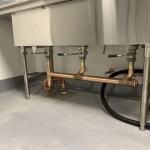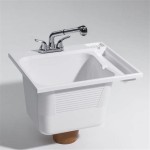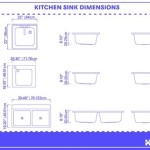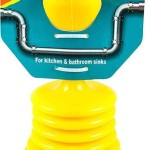Kitchen Sink Leaks At Handle: Causes, Diagnosis, and Repair
A leaking kitchen sink handle is a common household plumbing issue. While seemingly minor, persistent leaks can lead to significant water waste, potential water damage to surrounding cabinetry and flooring, and increased water bills. Identifying the source of the leak and implementing the appropriate repair is crucial to preventing these problems. This article explores the common causes of kitchen sink handle leaks, provides guidance on diagnosing the specific problem, and outlines the necessary steps for effective repair.
Kitchen sink handles are an integral part of the faucet assembly, controlling the flow of water from the supply lines to the spout. These handles operate by manipulating internal components, such as cartridges, o-rings, and valves, which regulate the water passage. Over time, these components can deteriorate due to wear and tear, mineral buildup, or corrosion, leading to leaks around the handle base. Understanding the mechanics of the faucet and the function of each component is essential for accurate diagnosis and successful repair.
Identifying Common Causes of Kitchen Sink Handle Leaks
Several factors can contribute to leaks originating from the handles of a kitchen sink faucet. The specific cause often depends on the type of faucet and the age and condition of its internal components. Common culprits include worn-out o-rings, corroded cartridges, loose packing nuts, and damaged valve seats. Properly identifying the root cause is the first step toward a lasting solution.
Worn-Out O-Rings: O-rings are small, circular rubber seals that create a watertight barrier between faucet components. They are commonly found around the faucet stem and cartridge. Over time, these o-rings can become brittle, cracked, or simply wear down due to constant friction and exposure to water. As the o-rings degrade, they lose their ability to effectively seal the connection, resulting in leaks around the handle base.
Corroded Cartridges: Cartridge faucets use a single handle to control both the water temperature and flow. The cartridge itself is a cylindrical component that regulates the mixing of hot and cold water. Mineral buildup, particularly in areas with hard water, can cause corrosion and damage to the cartridge. This corrosion can compromise the cartridge's ability to create a tight seal, leading to leaks. Internal components of the cartridge can also degrade, further exacerbating the problem.
Loose Packing Nuts: Packing nuts are threaded fasteners that secure the faucet stem or cartridge to the faucet body. If the packing nut becomes loose, it can create a gap between the stem or cartridge and the faucet body, allowing water to escape. Over time, vibrations from water pressure and regular use can cause the packing nut to loosen. In some cases, the packing nut itself may be damaged or stripped, preventing it from tightening properly.
Damaged Valve Seats: Valve seats are the surfaces against which the faucet valves or cartridges press to shut off the water flow. These seats can become corroded, pitted, or scored over time, preventing a complete seal. Damage to the valve seat can result in a constant drip or leak, even when the faucet is turned off. Replacing the valve seat is often necessary to resolve this issue.
Beyond the specific components, improper installation of the faucet can also contribute to leaks. If the connections between the faucet and the water supply lines are not properly tightened or if the faucet body is not securely mounted to the sink, leaks can occur around the handle area. Ensuring proper installation techniques from the outset is essential for preventing future problems.
Diagnosing the Source of the Leak
Before attempting any repairs, it is essential to pinpoint the exact source of the leak. A systematic approach to diagnosis will help identify the faulty component and ensure that the correct repair is performed. This process involves close visual inspection, careful observation of the leak behavior, and potentially disassembling the faucet to examine internal components.
Visual Inspection: Begin by thoroughly inspecting the area around the faucet handles. Look for signs of water accumulation, mineral deposits, or corrosion. Pay close attention to the base of the handles, the packing nut, and any visible connections. If the leak is intermittent or only occurs when the faucet is in use, observe the faucet while it is running to determine the precise point of origin.
Leak Behavior Observation: The behavior of the leak can provide clues about its source. For example, a constant drip even when the faucet is turned off suggests a problem with the valve seat or cartridge. A leak that only occurs when the handle is turned indicates a potential issue with the o-rings or packing nut. Noting whether the leak is related to the hot or cold water supply can also help narrow down the possibilities.
Faucet Disassembly (with caution): In some cases, it may be necessary to carefully disassemble the faucet to inspect the internal components. Before disassembling the faucet, turn off the water supply to the sink to prevent flooding. Use appropriate tools, such as a basin wrench and screwdriver, to remove the handles, spout, and other components. Examine the o-rings, cartridges, and valve seats for signs of wear, corrosion, or damage. Be sure to take pictures or create a diagram of the faucet assembly to ensure proper reassembly.
Hard Water Considerations: In areas with hard water, mineral buildup can significantly contribute to faucet leaks. Over time, minerals like calcium and magnesium can accumulate on internal components, causing corrosion, restricting water flow, and preventing proper sealing. If hard water is a concern, consider using a water softener or installing a faucet filter to reduce mineral buildup. Regularly cleaning the faucet components with a descaling solution can also help prevent future leaks.
Once the source of the leak has been identified, it is important to gather the necessary replacement parts before proceeding with the repair. Knowing the make and model of the faucet will facilitate finding the correct replacement o-rings, cartridges, or valve seats. Alternatively, the faulty component can be taken to a hardware store or plumbing supply store for matching.
Repairing Kitchen Sink Handle Leaks: A Step-by-Step Guide
Once the source of the leak has been identified and the necessary replacement parts have been acquired, the repair process can begin. This typically involves disassembling the faucet, replacing the faulty component, and reassembling the faucet. Patience and attention to detail are crucial for a successful repair.
Water Shut-Off and Preparation: The first and most important step is to shut off the water supply to the sink. This is typically done by turning off the shut-off valves located under the sink. If shut-off valves are not present, the main water supply to the house must be turned off. After shutting off the water supply, open the faucet to relieve any residual pressure in the lines. Protect the sink and surrounding surfaces with a towel or drop cloth to prevent scratches and water damage.
Faucet Disassembly: Carefully disassemble the faucet, following the steps outlined during the diagnostic process. Remove the handles, spout, and any other components that obstruct access to the faulty part. Use appropriate tools to loosen and remove nuts and screws, taking care not to damage any of the faucet components. As each component is removed, inspect it for wear, corrosion, or damage. Note the orientation of each part to ensure proper reassembly.
Component Replacement: Replace the faulty component with the new replacement part. For example, if the leak is caused by a worn-out o-ring, remove the old o-ring and carefully install the new o-ring. Lubricate the new o-ring with plumber's grease to facilitate a smooth fit and prolong its lifespan. If the leak is caused by a corroded cartridge, remove the old cartridge and install the new cartridge, ensuring that it is properly aligned and secured. Similarly, if the valve seat is damaged, remove the old valve seat and install the new valve seat, making sure it is seated correctly.
Faucet Reassembly: After replacing the faulty component, carefully reassemble the faucet, following the reverse order of disassembly. Ensure that all components are properly aligned and securely tightened. Avoid overtightening nuts and screws, as this can damage the faucet components. Reconnect the water supply lines, making sure the connections are tight and leak-free. Turn on the water supply slowly and check for leaks around the handle base and other connections.
Testing and Adjustments: Once the faucet has been reassembled and the water supply has been turned on, thoroughly test the faucet to ensure that the leak has been resolved. Turn the handles on and off several times, checking for any signs of dripping or leaking. Observe the water flow and temperature to ensure that the faucet is functioning properly. If any leaks are detected, tighten any loose connections or repeat the disassembly and reassembly process, paying close attention to the alignment and seating of the components. Minor adjustments may be necessary to achieve a perfect seal.
Addressing kitchen sink handle leaks promptly prevents more serious plumbing issues. While some repairs are straightforward, complex problems may warrant consulting a qualified plumber. When in doubt, professional assistance can ensure proper diagnosis and lasting solutions.

How To Fix A Leaky Faucet With Single Handle Design

Stop Faucet Handle Leaking How To Replace A Kitchen Valve

Plumbing How To Fix A Small Faucet Leak At The Base Home Improvement Stack Exchange

Easy Fix Kitchen Faucet Leaking How To A Leaky In 1 Minute Youtube

How To Repair A Leaky Single Handle Cartridge Faucet

Kitchen Faucet Leaks At The Base Easy 5 Min Fix Youtube

How To Fix A Leaky Faucet Handle Beginner Friendly Guide

Sealing A Leaky Faucet Base Plate 1 Tom Plumber

Why The Edges Of Kitchen Sink Leak Mr Rooter

How To Fix A Dripping Or Leaky Single Handle Faucet







